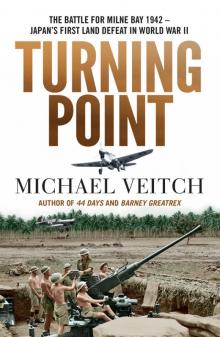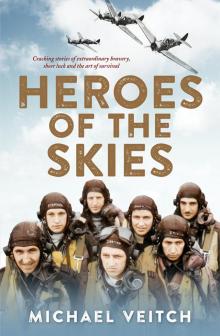- Home
- Michael Veitch
Turning Point
Turning Point Read online
Michael Veitch is well known as an author, actor, comedian and former ABC television and radio presenter. His books include the critically acclaimed accounts of Australian pilots in the Second World War, Heroes of the Skies, Fly, Flak, 44 Days and Barney Greatrex. Turning Point is his ninth book. He lives in the Yarra Valley, outside Melbourne.
CONTENTS
About the Author
Title Page
Also by Michael Veitch
Map
PrologueA Jungle Runway
PART ONEPRELUDE TO BATTLE
1 A Peculiar Battle
2 The Obscure Outpost
3 The Race for a Base
4 The Build-up
5 Where are the Japanese?
6 Field Takes Charge
7 An Unexpected Arrival
8 The Kittyhawks Arrive
9 Problems with the Camp
10 The Pilots Settle In
11 Silent Cyril
12 Japanese Plans
13 Nippon’s Marines
14 Strike from the Air
15 First Blood at Goodenough Island
16 Battle Lines
PART TWOTHE BATTLE
17 Invasion
18 Blood on the Water
19 The Landing
20 The Kittyhawks Strike
21 To KB Mission
22 Changing Orders
23 The RAAF’s Worst Loss
24 The Fight for KB Mission
25 The Bloody Track
26 The Kittyhawks Depart
27 Reinforcements
28 No. 3 Strip
29 The Greatest Battle
30 The Counterpunch
31 The End for the Japanese
32 The Webb Report
EpilogueTokyo, 2018
Sources and Acknowledgements
Bibliography
Index
Picture Sections
Copyright
ALSO BY MICHAEL VEITCH
44 Days: 75 Squadron and the fight for Australia
Barney Greatrex: From Bomber Command to the French
Resistance – the stirring story of an Australian hero
‘Some of us may forget that of all the Allies, it was the Australian soldiers who first broke the spell of the invincibility of the Japanese Army.’
William Slim
PROLOGUE
A JUNGLE RUNWAY
On the worst day of the battle – that strange and confusing Saturday when nothing was certain and everything hung in the balance – a pilot stood on the edge of a perforated metal runway, his face expressionless, focusing as best he could on the impenetrable wall of jungle in front of him. His tropicalissue khaki shirt was filthy, and his sallow skin glowed with a permanent sheen of perspiration. He swayed slightly – like a man drunk – from fever and exhaustion, but his hollow eyes remained fixed on the green line to the east. Muffled sounds of battle leached through the tangled, steaming jungle; they were soft and far-off, and even strangely comforting. But he was not fooled. Whatever was happening out there was, he knew, close.
His concentration focused by the sickness, he could distinguish the airy whoomph of exploding 3-inch mortars, and the sharp crack of .303 rifles and automatic weapons. Then a deep boom from the battery of 25-pounders, like the distant steps of a giant stomping through the foliage. He thought of those artillerymen from the 2/9th Field Regiment he’d seen around the camp before the fighting started: serious-looking AIF blokes who kept to themselves. It sounded now like they’d found their range.
‘Jesus,’ he muttered.
Over to his left, one of 76 Squadron’s Kittyhawks rested at its dispersal, while a couple of fitters were washing off the muck and filth which yet again caked the flaps and undercarriage. At his feet, the metal matting rocked slightly – like the deck of a ship, he thought, sailing on a dark liquid ocean. It oozed up black over his boots. He was used to it now. Didn’t even shift his feet.
‘What’s happening?’ he called in the direction of the ground crew, not really expecting an answer, and immediately wished he hadn’t. Saying anything brought on a rush of nausea – whether from the malaria or the Atebrin tablets which were supposed to suppress it, he had no idea.
He really should have stayed in the sick bay, but what was the point? Lying there on a filthy stretcher under a dripping tent, feeling useless. It was just as impossible there as anywhere else to avoid the mud, the heat, the insects and the endless, endless rain. So he’d got up, thanked the doc, who just shrugged his shoulders, then made his way over to the operations tent and put his name back on the flight list. Just in time. Because now, for those blokes out there – those poor terrified bastards somewhere in that jungle, just a mile or two away – it was on.
He looked up at the sky. Was it morning or evening? He could barely tell. This featureless soup cloaked the entire day in a miserable dusk, and the wet mist hung like lead, never seeming to lift. And behind that, all around, were mountains. ‘Clouds filled with rocks,’ someone had quipped. Taking off into it was terrifying. Or at least it had been, during the first few weeks. Now he was too tired to notice.
He looked at his watch, out of habit, and swore. It had stopped working days ago.
Five days earlier, the Japanese had finally turned up. Five days of almost continuous flying around this monotonous, dead-end jungle, and he still couldn’t get his bearings. In fact – thinking about it – there wasn’t actually much flying involved at all. Standing patrols and recce jobs had been the go before the battle started, but now it was all about strafing: strafing the jungle, strafing the mangroves, strafing the landing areas – strafing anywhere the enemy could be lurking under that endless canopy of trees. Sometimes he’d have his thumb on the gun button even before his wheels were fully up, wrenching his aircraft off the runway, then swinging hard around on a wingtip and blasting away at a featureless stretch of grey-green foliage the army boys had fired flares into, denoting the enemy, often just a few hundred yards ahead. As one of the 75 Squadron pilots had put it, ‘It’s like taking off from the Sydney Showgrounds and shooting up Darlinghurst.’ Only you could almost never see what you were shooting at.
But they were out there and getting closer. And those army and militia boys were right in the middle of them. However tough it was for the pilots, it was worse, far worse, for those blokes on the ground.
The stress was incredible. If he messed it up just once – got things arse about or back to front – or missed something in this ocean of green, allowing himself to succumb to a moment’s disorientation, he could, in a heartbeat, commit the unthinkable and fire on his own people. The thought went through his mind every time his guns let rip. Or if he banked around too hard, or pulled up too fast, or even too slow, he could stall the plane and go in. At this height, he’d be spread across the jungle floor in an instant. It’d happened just a few days ago to – of all people – the boss, Pete Turnbull, 76 Squadron’s CO, a man with a full combat tour in the desert under his belt. Late in the day, he’d come up too slow from a strafe run against a Japanese tank and the air sucked out from under his wings. His big and heavy Kittyhawk had fallen into the jungle like a stone. Or maybe he was just exhausted. At any rate, Pete Turnbull was one hell of a pilot. Now he was gone. Somewhere out there.
Several times a day, the word had gone up. ‘It’s on!’ a voice would yell. He’d haul himself into the cockpit, push the throttle wide open and thunder down the runway, the big prop fanning mud and filth everywhere. Landing was even more of a nightmare: the Kittyhawk thudding onto the deck like an old truck on a rutted road; trying to keep her straight on the sodden and greasy metal surface; working the brakes and rudder to avoid swinging as his tyres hit the puddles and pools; swearing blind. The guns were still smoking and the pr
op still turning as the armourers scrambled up onto the wings to rip off the covers and replenish the boxes with long, greasy belts of half-inch ammunition. Then, after a cigarette – a few minutes to get over the shakes – he’d be up again. Sometimes they didn’t even need to refuel. These trips weren’t long enough for that.
Since his arrival he’d gone from novice to veteran, cramming months of combat flying into a couple of weeks, and all of it close by this sodden airstrip the Japanese seemed hell-bent on taking. Streaming out of that jungle and taking. But they weren’t going to bloody take it, not if he and his mates in 76 and 75 Squadrons could help it. And the same went for those militia blokes on the ground: just kids, or so they seemed, pale and scared – but determined. Likewise the AIF fellas from the 18th: tough bastards with sand in their boots from the fighting in Libya and Tobruk. But they’d never seen anything like this place.
He could see it in their eyes. They weren’t going to let them through either. None of them were.
‘Snipers!’ someone shouted. ‘Watch out for bloody snipers!’ The pilot’s nausea cleared in a moment. They’d been warned about them: slipping silently ahead of their own positions in bunches of twos and threes, then with climbing irons, slithering up into the fronds of the coconut trees, lying dormant for days, like coiled snakes, living off rainwater and a handful of rice a day, with no expectation whatsoever of coming down alive. Even when wounded, they could still get off a couple of rounds before they bled to death. At least that was the rumour. Christ the bastards are barely human.
‘Fuck it,’ he said, and spat. Turning with a sudden urgency towards the ground crew, he gestured to a couple of lads in filthy khaki shorts. ‘You two, pull her round.’ They looked at each other, uncertain. ‘Now!’ he barked.
Energised by his idea, the pilot now moved with the speed of a cat. Putting his shoulder into the wing root, he indicated another man do the same, and the three of them pushed the big green fighter clear of its dispersal bay. ‘Line her up this way,’ he said, pointing to the long, straight line of green which ran beside the runway apron, cleared by the machines of the American engineers a few weeks before. Leaping onto the wing, the pilot launched himself into the cockpit.
The young crewmen looked bewildered. ‘I didn’t hear the scramble, sir,’ said one of them.
‘Both you blokes get on the tail,’ he replied. ‘I’m not bloody flying it.’
Positioning themselves on either side of the elevators, the crewmen complied. Then they heard the whirring of the battery and the electrics being engaged.
‘Now, when I say move her to the left, move her to the left, okay?’
The two nodded. Then all hell broke loose.
The aircraft’s machine guns opened up, lines of roaring flame and tracer shooting ahead of them towards the tops of the coconut trees a few hundred yards away. The foliage disintegrated as if struck by the swings of a gigantic scythe.
‘Now left – go left!’ he yelled, still seated in his cockpit, his thumb squeezing short bursts on the firing button. The men at the back lifted the tail of the aircraft slightly, and pulled it around on the wheel.
‘That’s it!’ called the pilot. Another burst, another shredded row of coconut crowns.
They got the idea. ‘Right a bit!’ and back they traversed along the arc of ferocious fire. Spent brass shell casings poured out from under the wings, clattering onto the metal matting. Finally, the guns gave a click and fell silent, and the pilot switched off the aircraft’s electrical system and the spinning magnetos went quiet.
Slowly, he pulled himself out of the cockpit and climbed down. ‘Better load her up again, boys,’ he said. ‘No fucking Jap sniper’s gonna get me.’
This story was told to me by a 76 Squadron pilot who was there, and who swore it was true. ‘That was Milne Bay,’ he said.
PART ONE
PRELUDE TO BATTLE
CHAPTER 1
A PECULIAR BATTLE
There was no inevitability to the Japanese defeat at Milne Bay. Today, the clarity of hindsight marks the ten-day battle in the far east of Papua as the zenith of Japan’s bloody advance across the south-west Pacific, her high tide of conquest delineated by the piles of blasted olive-green corpses of marines lining the eastern edge of a lonely jungle airstrip. Not a single aircraft had yet taken off from its hastily constructed surface. Even its utilitarian name had yet to evolve from that given it by the engineers who had barely finished carving it into the jungle: ‘Number 3’.
Soon after the battle, a small cairn was erected to mark the point at which the Japanese were stopped, from where they would begin their long, slow retreat, ending over 3000 miles away at Hiroshima and Nagasaki, three bloody years later. But no-one could guess this in August 1942, at Milne Bay.
If even a single of the various elements which foiled Japan’s audacious plan to force a pincer on nearby Port Moresby had fallen their way – or if they had not succumbed to their own hubris, performed some reconnaissance and planned their attack better – the outcome of the brief but savage campaign could have been different.
Milne Bay was a peculiar battle, fought largely in the dead of night in unspeakable conditions by men exhausted and often sick, with many on both sides new to combat. It was a battle of a thousand crazy skirmishes fought in pitch black, illuminated only by muzzle flashes, flares or the blinding spotlights of the Japanese tanks that pierced the jungle, defying the best efforts of Australian riflemen to shoot them out. It was fought at frighteningly close quarters in blind and savage gropings, where the bayonet was used as frequently as the rifle. The voices of the enemy could be easily heard – laughing, shouting and even taunting – sometimes in perfect English. As the battle went on, the Australians’ daily passwords were selected from words beginning with L – Life, Lewis, Lonely, Little – to confound the Japanese attempts to mimic them.
As The Central Queensland Herald put it, ‘On the ground the fight was against an almost invisible army. Short, sharp bursts of machine-gun fire were the only sounds breaking the long periods of silence, giving the whole battle a macabre quality.’
Although fought within the chronological framework of the long Kokoda campaign, which raged over four months across the great distances of the Owen Stanley Range to the north, Milne Bay was, by contrast, a short, sharp and vicious affair, which see-sawed along a sodden strip of jungle coastline, hemmed in by mountains on one side and the sea on the other. Running through the middle was the miserable stretch of muddy road over which both sides were desperately battling.
It was fought – on one side – by the hardened elite of an army long inured to exactly this type of jungle fighting, whose savagery on the battlefield defied comprehension, and who, in nine months of conquest, had yet to be stopped on land by any Allied force arrayed against them. So confident were the Japanese of victory at Milne Bay that initially they abandoned all pretence of stealth. The spearhead of their navy marines marched into battle shouting, singing, even banging tins to amplify their presence. This was to be another walkover, in which a weak and cowering enemy would wither before them.
Opposing them were men whose experience of fighting was against Germans and Italians in the desert on the far side of the world, and other men who had yet to fight anyone, anywhere.
It was fought in an ocean of stinking tropical mud, under a permanent grey sky which excluded all but the briefest rays of sunshine for the entire battle. And it was fought in the rain. For three weeks prior to the fighting in late August, the heavens had opened in a deluge, extreme even for this notoriously wet region of Papua. Rain fell in relentless downpours that left not a surface dry. Flat land was transformed into a single gigantic bog. Like their fathers had done on the Western Front of the Great War, men waded through thigh-deep mud which sucked their boots from their feet. Canvas tents and beds rotted before their eyes. Roads were virtually impossible to construct, and soon became impassable anyway. Simply walking short distances was a dispiriting and enervating ordeal. T
he temperature rarely dropped below 30 degrees Celsius, and the humidity, beyond anything experienced by all but a few, sapped the men’s energy and made the very air thick to breathe.
And the disease. Because of ignorance, incompetence or both, the men of Milne Force were delivered into battle utterly unprepared for the ravages of the tropics, particularly malaria. Whining clouds of Anopheles mosquitoes rang constantly in their ears, introducing the malaria-causing Plasmodium falciparum parasites into their bloodstreams within days. No-one was ready for it. Long-sleeved clothing failed to be issued. Mosquito nets were inadequate or did not arrive. Antimalarial drugs such as quinine and Atebrin were in short supply, and often prescribed in the incorrect dosage. Hundreds were forced to live, fight and die under the dreadful feverish pall of the disease, and many of the survivors would carry the symptoms with them for years.
Even the issue of essential stores such as tents were mucked up in logistical ineptitude that would be comical if not for the consequences. One soldier reported that half his unit were issued only the tents, and the other half only the flies. Both proved inadequate in the nightly downpours, and men were soaked to the skin in their beds, depriving them of invaluable rest.
Despite this, Milne Bay would be, in the end, a noble and unquestioned victory. And an Australian victory at that, but one won also with the incalculable assistance of tireless American combat engineers turned infantrymen, and the material largesse that their great nation could provide. Of this, surely no element was more important than the innovation of prefabricated metal Marston matting, which allowed runways to be laid down virtually anywhere, enabling the deployment of modern and powerful aircraft. Deployed for the first time at Milne Bay, the Marston mat would prove itself in almost every theatre of the Second World War.
Radar, too, played its part, as did the heroic and still underappreciated deeds of Australia’s wartime code breakers and Coastwatchers, who accurately reported from their lonely jungle vigils the progress of Japanese convoys and naval reinforcements, and who monitored the southbound formations of red-circled aircraft, providing timely warning of air attacks.

 Turning Point
Turning Point Heroes of the Skies
Heroes of the Skies The Forgotten Islands
The Forgotten Islands Hell Ship
Hell Ship Flak
Flak Fly
Fly